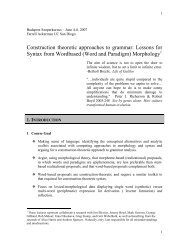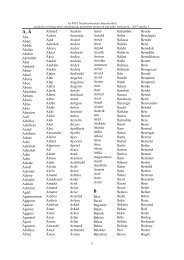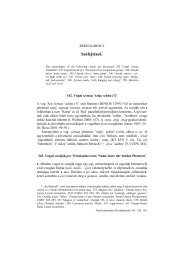Nyelvtudományi közlemények 91. kötet (1990)
Nyelvtudományi közlemények 91. kötet (1990)
Nyelvtudományi közlemények 91. kötet (1990)
Erfolgreiche ePaper selbst erstellen
Machen Sie aus Ihren PDF Publikationen ein blätterbares Flipbook mit unserer einzigartigen Google optimierten e-Paper Software.
208 TRYGGVE SKOLD<br />
en fimfta tigar "he had 8 winters in the fifth decade" (Menninger 1969. 27).<br />
Now Reuter (1933. 370ff), and after him Menninger (1969. 80, 112), assume<br />
that this way of counting was borrowed by the Finns. Reuter holds<br />
the view that it was carried by trade to the Ostyaks and even farther east<br />
(cf. also Bergsland 1953. 52). In Finnish, 24 can alternatively be rendered<br />
as neljä kolmatta [kymmentä], thus "4 from the third [ten]". Overcounting<br />
is obligatory in the numerals 11-19, e.g. yksi toista [kymmentä] i.e. "one<br />
from the second [ten]", usually written yksitoista, etc. In still another respect,<br />
influence from the Baltic or Germanic peoples could be assumed. In<br />
Finnish, the numeral of a plurale tantum is put in the plural, in agreement<br />
with the head-word. The "classic" example, occurring in most primers and<br />
grammars, is kahdet häät 'two weddings', in inessiv e.g. ainoastaan kaksissa<br />
häissä 'at only two weddings' (see e.g. Denison 1957. 71, Collinder I960. 236,<br />
A. Seppänen 1983. 167, 169). This pattern is of course in contradiction with<br />
the whole way of thinking of the Fenno-Ugric languages, where the numerals<br />
and their head-words are treated as singular, and where the plural as<br />
such is suspect. It is therefore natural to look upon this construction as a<br />
caique on the corresponding patterns in the neighbouring Indo-European<br />
languages (see Ravila 1941. 61, Ingo 1978. 56f, 256f; for the Indo-European<br />
pattern cf. Brugmann-Delbriick 1911. 80, Löfstedt 1958. 100 ff, 218ÍF, Stang<br />
1966.284).<br />
I could also, en passant, remind the reader of the following: that it is a<br />
matter of discussion if we have any numerals at all common to the Samoyedic<br />
and the Fenno-Ugric languages (see e.g. Donner 1933, Rostek 1937. 112f,<br />
Ross 1944. 91f, Kovács 1960 1960. 128), that only the numerals 1-6 are<br />
common to the Fenno-Ugric languages (see e.g. Ross 1944. 91, Bergsland<br />
1953. 47, 53, Kovács 1958. 346, E. Itkonen 1973. 334), and that some of the<br />
higher numerals are loan-words from the Indo-European languages.<br />
I have assumed, in an earlier paper, that the whole decimal system as<br />
such was borrowed by the Fenno-Ugrians from the Indo-Europeans (T. Sköld<br />
1985. 100). After having studied some works on counting in general, I am<br />
now more inclined to suppose that the decimal system is indigenous among<br />
the Fenno-Ugrians, for it is a very common system in the languages of<br />
the world (see e.g. Hagstroem 1931. 25, 32, Kovács 1958. 347, Szemerényi<br />
1960. VIII, Menninger 1969.112, cf. however Kovács 1958.352). The fact<br />
that some of the words for 10 in the Fenno-Ugric languages are borrowed,<br />
however, speaks in another direction (see T. Sköld 1985).<br />
From the traits I have just treated, it is obvious that there has been a<br />
heavy impact on the Finnish numeral system from the neighbouring Indo-<br />
European languages. Based on this, I think it is fair to assume that the<br />
Nyelvtudományi Közlemények <strong>91.</strong> <strong>1990</strong>.


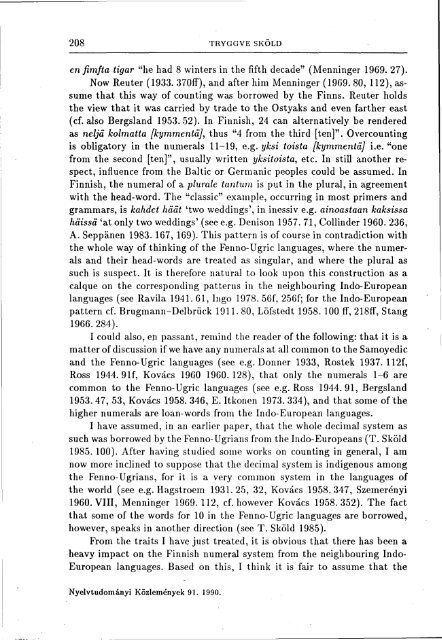

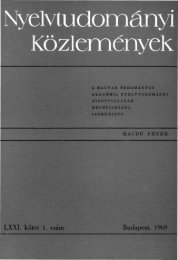

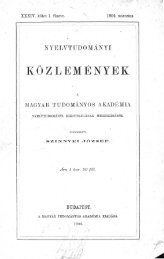
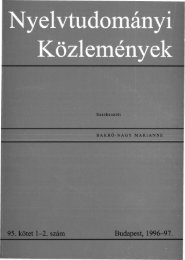
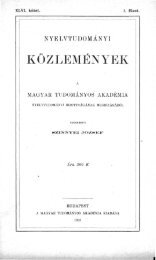
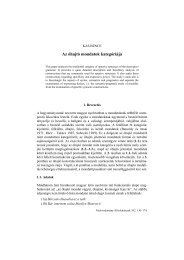
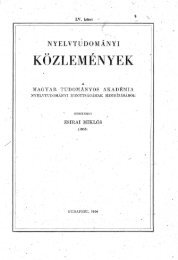
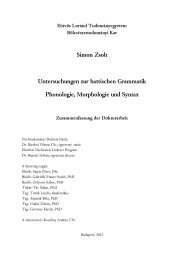
![Gósy Mária: A [p, t, k] mássalhangzók zöngekezdési ideje Bevezetés ...](https://img.yumpu.com/15682849/1/190x245/gosy-maria-a-p-t-k-massalhangzok-zongekezdesi-ideje-bevezetes-.jpg?quality=85)

